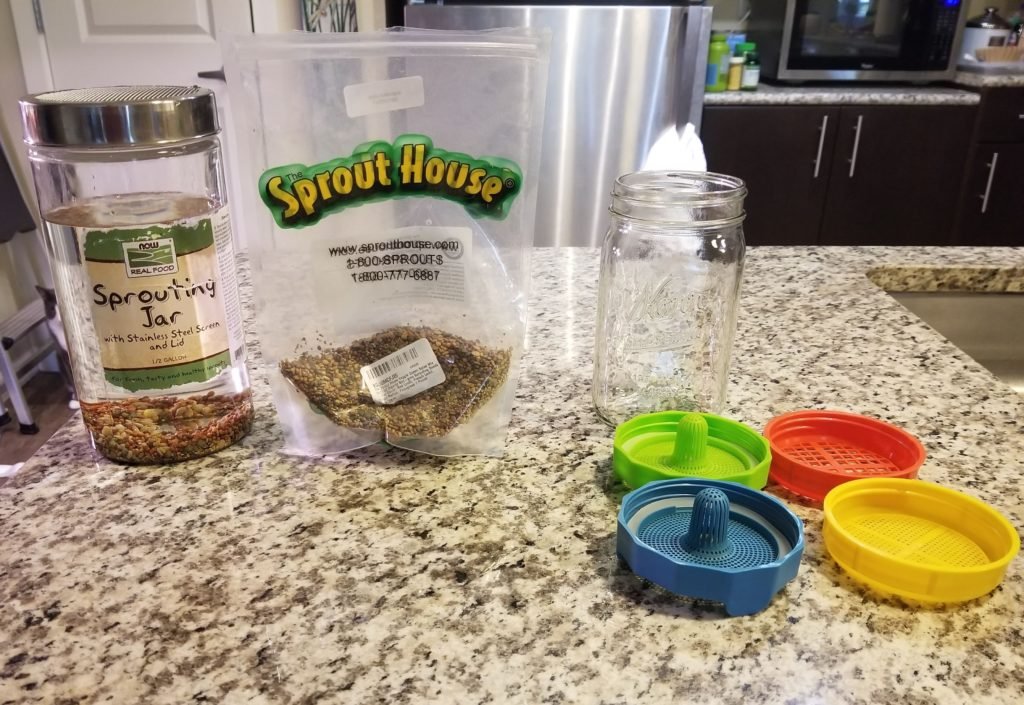You’ve seen them at the grocery store, in the specialty area of your produce section – a small, wilted, slightly browning little plastic clamshell container with alfalfa sprouts. For me, finding that sad little vegetable again and again inspired me to want better greens.
This is a vegetable you can grow yourself, even in an apartment without access to a patio! Sprouts can and should be a mix of many wonderful greens, not just alfalfa. Think radish, lentil, clover, alfalfa, and even mung. Their flavors range from spicy to nutty to herbal, and you can serve them in more ways than you may have thought possible.
Sproutpeople.org has a handy table showing the nutrition facts for various types of sprouting seeds. For example, fenugreek sprouts are fragrant and a touch bitter and have high protein, Vitamin A, and are good for digestion. Radish sprouts have a spicy flavor and provide Vitamin C; they are good sources of Calcium, Iron, Magnesium, and Potassium. And lentil sprouts, with their nutty flavor, are high in Vitamins A, B, C and E and provide Calcium, Iron and Phosphorus.
I like my sprouts on top of eggs in the morning, mixed into green salads, layered into wraps and burritos, and sometimes on top of broiled salmon or chicken as a garnish. You don’t have to prep or cook them beyond simply washing them, which makes sprouts the easiest vegetable to add into your daily meals. Take a container of them along on road trips so you can boost the nutritional content of your restaurant food as well. Then you can tuck them into those breakfast burritos and submarine sandwiches. If you try growing your own sprouts, it won’t be long before you are dissatisfied with any sandwich or burrito that doesn’t have them!
They are inexpensive to grow as well. I buy a 1-lb bag of mixed sprouting seeds from Amazon (there are plenty of other retailers that also offer them) and they last me at least 6 months at a cost of $10 or less.
The Sprout House, which makes my favorite sprouting mixes, offers these instructions: “Soak the seeds in the jar. Put 1 to 4 tablespoons of seed in the jar. Add water and soak overnight about 8 to 10 hours. Most seeds can be soaked for 24 hours with a water change in the middle at 12 hours. 2. After you have soaked the seeds, drain out the water, making certain there are only wet seeds left in the jar, no standing water. 3. Rinse the seeds with fresh water, drain out the water, making certain there are only wet seeds left in the jar, no standing water. 4. Twice each day, rinse the seeds with fresh water, drain out the excess water, making certain there are only wet seeds left in the jar, no standing water.”

The equipment is very simple. My favorite is just a regular wide-mouth quart-size canning jar with a sieve-like plastic lid from Amazon. Before that, I had a set of 3 plastic lids in varying mesh sizes also designed to fit on canning jars. There are larger multi-tray systems out there, but I have found that I will more often use the jar systems – the smaller, the better, so you don’t have to make space for it. The jars need to be wide-mouth because the sprouts will fill up the whole jar in 4 days and it will be difficult to slide them out into a storage container unless it is wide.
Quick Tips for Growing Sprouts
- Use a jar system or something similar that is small and light
- Rinse and soak your seeds for 1 hour to overnight for faster sprouting
- For a 1-quart jar, use about 2 Tbs seeds
- Rinse every time you come in the kitchen or 3-4 times per day
- After rinsing, store upside down or on its side (I put in the dish drainer)
- No extra light is needed on the sprouts
- Rinse with water only – no fertilizers or chemicals
- After 4 days or so, dump sprouts into a large mixing bowl filled with cold water and swish gently to remove most of hulls. Move clumps of sprouts using clean hands into plastic storage containers and refrigerate
- Rinse sprouts daily after refrigerating to keep them fresh
- Use sprouts within about a week for best flavor and texture
Want to learn more? I got a lot of good advice from The Sprouting Book: How to Grow and Use Sprouts to Maximize Your Health and Vitality, printed in 1986. I see that Joel Fuhrman, the author of Eat To Win and The End of Diabetes, has also co-written a book with Doug Evans on the subject, The Sprout Book: Tap into the Power of the Planet’s Most Nutritious Food. I might check that out, too.